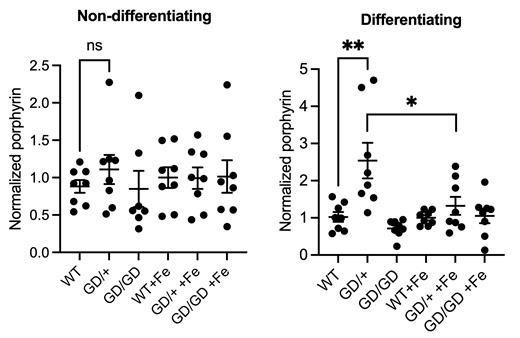Terminally differentiating red cells synthesize large quantities of heme for hemoglobin production, requiring tight coordination between mitochondrial iron import and synthesis of photosensitive protoporphyrin IX (PPIX). PPIX causes erythropoietic porphyria from loss of function mutations in FECH, or gain of function mutations in ALAS2. We previously reported that a dominant heterozygous point mutation in human CLPX (G298D) was a novel cause of erythropoietic protoporphyria (Yien et al. 2017, PNAS). CLPX encodes a ubiquitous ATPase-dependent mitochondrial protein unfoldase and is required for tight regulation of the mitochondrial heme synthesis enzymes, ALAS 1 and 2, FECH and PPOX, as well as mitochondrial iron utilization. CLPX facilitates degradation of the ALAS enzymes, but paradoxically, is also required for activity of the PPOX and FECH enzymes. CLPX function is required for porphyrin synthesis and for the incorporation of iron into heme (Rondelli et al. 2021, JBC). Because the role of CLPX in heme regulation is complex and cell-specific, we sought to interrogate the mechanism by which the CLPX G298D mutant protein caused erythroid protoporphyria.
To determine the requirement for CLPX for maximal heme synthesis, we labeled wild-type and Clpx -/- 3T3 murine fibroblasts and G1E-ER4 erythroid cells with 14C-aminolevulinate (ALA) and measured heme synthesis by liquid scintillation to ensure that equal amounts of labelled ALA were entering the heme synthesis pathway, uncoupling the effects of CLPX on the first and terminal steps of heme synthesis. We found that Clpx -/- cells synthesized significantly less 14C-ALA -labelled heme, indicating that CLPX is required for activation of the terminal heme synthesis enzymes in both erythroid and non-erythroid cells. Mass spectrometric quantification of FECH and PPOX protein and enzyme activity assays indicated that their protein levels and activities were decreased in Clpx -/- cells.
Since CLPX ubiquitously regulates the mitochondrial steps of heme synthesis, we sought to determine why the porphyrin accumulation in CLPX -EPP predominantly occurred in erythroid cells and to interrogate the pathogenic mechanism of CLPX-EPP. To address this question, we knocked in the human G298D/mouse G299D mutation into murine erythroleukemia cells. The heterozygous mutant cells, denoted as WT/G299D, synthesized normal levels of heme. Further, differentiating WT/G299D cells synthesized significantly more porphyrin than wild-type cells, phenocopying the patient. In contrast, non-differentiating WT/G299D cells produced wild-type levels of porphyrin. ALAS2 was stabilized in the mutant expressing cells, likely accounting for the increase in porphyrin during erythroid differentiation. Iron supplementation was effective in decreasing photosensitivity and porphyrin levels in the patient (Ducamp et al., Hematologica 2021) as was predicted for porphyrias caused by increases in ALAS2 activity (Landefeld et al., Br. J. Hematol. 2016). Similarly, supplemental iron was also able to decrease porphyrin levels in WT/G299D cells to wild-type levels (Figure 1). In contrast to the WT/G299D cells, wild-type cells did not experience a decrease in porphyrin synthesis. We also did not observe increased heme synthesis with iron supplementation, indicating that iron, rather than promoting heme synthesis, is inhibiting an upstream step of porphyrin synthesis in WT/G299D cells. Secondly, co-immunoprecipitation assays indicated ATPase activity or ATP binding was dispensable for the interaction between CLPX and PPOX/FECH, likely accounting for the normal heme synthesis observed in CLPX G299D expressing cells. Lastly, the G299D mutant protein has decreased ALAS degradation activity, while retaining its ability to activate PPOX/FECH. This indicates that the CLPX protein is multifunctional in heme regulation.
The control of heme synthesis by CLPX unveils a novel cause of protoporphyria and the erythroid specificity of the disease indicates that CLPX has erythroid-specific functions in heme regulation. Further, while iron promotes ALAS2 translation, iron supplementation also suppresses porphyrin synthesis in CLPX-EPP. We reveal an important erythroid-specific regulatory node where the mitochondrial protein homeostasis intersects with heme synthesis, offering important insights on the pathogenesis and treatment of porphyrias.
Disclosures
No relevant conflicts of interest to declare.


This feature is available to Subscribers Only
Sign In or Create an Account Close Modal